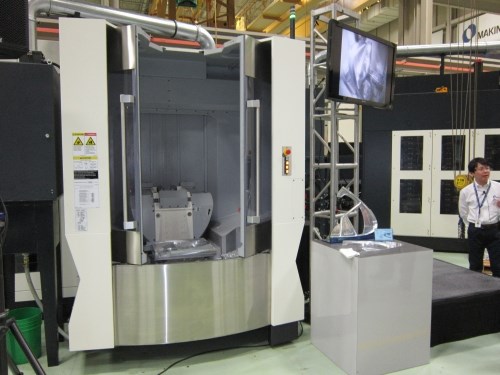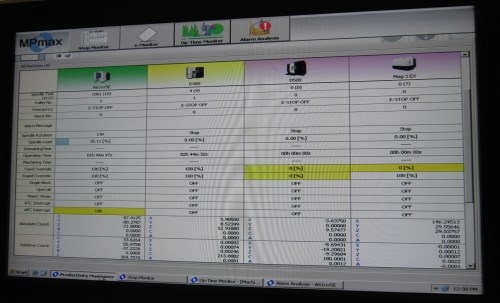Event Highlights Solutions for Aero Structural Parts
The thin walls and deep pockets common to structural aerospace parts make machining challenging. A recent event at Makino’s U.S. headquarters highlighted solutions for effectively machining such tricky aluminum and titanium components.
Share





On April 30, I attended an event hosted its U.S. headquarters in Mason, Ohio that highlighted solutions for effective production of aerospace structural components. The event featured a number of machining demonstrations for both aluminum and titanium components.
For example, the company’s T2 and T4 machines are well-suited for big titanium components. The T2 offers six-axis positioning and 5-axis contouring capabilities to reduce the number of setups and refixturing time which helps ensure feature-to-feature accuracy. The larger T4 is effective machining parts with thin walls and floors, deep pockets, and hard-to-reach corners with its ±110 degrees of A-axis travel and rigid construction.

Visitors were also able to see a number of five-axis machining demonstrations for aluminum structural components, including Makino’s MAG and DP series machines. The company also highlighted what it calls “right size” machines for smaller aerospace structural components. One example is the a61nx-5E, which is a 24,000-rpm five-axis horizontal machine built on a 500-mm HMC platform. At the event, it was machining an aluminum landing edge segment, demonstrating one-shot wall finishing, high speed floor finishing and material removal rates as high as 300 cubic IPM. The machine features an atypical pallet changing system for its twin, direct-drive rotary tables that brings effective ergonomics to five-axis machining. This video shows a pallet change whereby a vertically fixtured pallet is removed from the workzone, rotated 180-degrees and presented horizontally to an operator. At the same time, the pallet on the opposite rotary table is loaded into the machine.

The event also featured a presentation by representatives of , which has recently integrated Makino’s MPMax shopfloor data visualization and management software. In 2012, the shop began a process of accounting for all available spindle time and categorizing downtime for analysis. It purchased MPMax to aid in data collection and reporting of spindle utilization. For example, a shop monitor (like the one shown below) reports real-time status of machines with numerous live data points. In addition, status charts offer a quick snapshot of how machines are being utilized so managers can get a good visual about utilization gaps over periods of time.
Exacta’s mantra is “if you can’t measure it, you can’t manage it.” It feels its approach to tracking spindle utilization will help with costing and planning because utilization levels are no longer assumed. Plus, live, auto-updating reports will provide increased visibility and accountability while keeping the focus on continuous improvement.

Related Content
-
AFRC, ATI Partner to Boost Aerospace Materials Innovation
ATI Inc. has joined the University of Strathclyde’s AFRC as a tier one member, aiming to develop metallic alloys that support sustainability in the aerospace sector.
-
Sandvik Coromant Inserts Provide Stable Turning of Aerospace Components
The new insert grades GC1205 and GC1210 cover a large application area within last-stage machining and intermediate-stage machining when turning aerospace engine components.
-
Broaching Tool Technology For Lathes Used to Slot Inconel Parts
This shop finds value in using an indexable-insert-style broaching tool to create blind-hole slots in heat-treated Inconel aerospace parts on a CNC lathe.
















